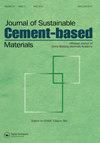Understanding the mechanisms behind the effects of limestone powder on microstructure evolution of cement paste
IF 4.2
3区 工程技术
Q1 CONSTRUCTION & BUILDING TECHNOLOGY
Journal of Sustainable Cement-Based Materials
Pub Date : 2022-11-11
DOI:10.1080/21650373.2022.2144534
引用次数: 5
Abstract
Abstract In cement-based materials, the microstructure evolution is a key factor that determines the mechanical, rheological and transport properties. However, the principal mechanism of microstructure evolution becomes more complicated due to the incorporation of limestone powder. In this paper, the effects of limestone powder are divided into filling effect, dilution effect, nucleation effect and its negative feedback effect. The hydration of paste is controlled by the nucleation and dilution effects, while the microstructure evolution of paste is determined by the nucleation, dilution and filling effects of limestone powder. Based on this, the HYMOSTRUC model was used to investigate the effect of content and specific surface area of limestone powder on microstructure evolution. In order to reveal the mechanism of microstructure evolution, a model of evolution of interparticle force is developed, in which the transition between the force of cementitious particles and the C–S–H cohesion is determined by cement hydration. By applying the model, the relationship between microstructure evolution and interparticle force was established, and the effect of limestone powder on microstructure evolution can be divided into five stages on the time scale depending on the action mechanism of interparticle forces.了解石灰石粉末对水泥浆体微观结构演变影响的机制
在水泥基材料中,微观结构的演变是决定其力学、流变和输运性能的关键因素。然而,由于石灰石粉的掺入,微观结构演变的主要机制变得更加复杂。本文将石灰石粉的作用分为充填效应、稀释效应、成核效应及其负反馈效应。膏体的水化受成核和稀释效应的控制,而膏体的微观结构演化则受石灰石粉的成核、稀释和充填效应的影响。在此基础上,采用HYMOSTRUC模型研究了石灰石粉含量和比表面积对微观结构演化的影响。为了揭示微观结构演化机制,建立了胶凝颗粒间力演化模型,其中胶凝颗粒力与C-S-H内聚力之间的过渡由水泥水化决定。应用该模型,建立了微观结构演化与颗粒间力的关系,根据颗粒间力的作用机理,在时间尺度上将石灰石粉末对微观结构演化的影响分为5个阶段。
本文章由计算机程序翻译,如有差异,请以英文原文为准。
求助全文
约1分钟内获得全文
求助全文
来源期刊
CiteScore
6.60
自引率
15.90%
发文量
71
期刊介绍:
The Journal of Sustainable Cement-Based Materials aims to publish theoretical and applied researches on materials, products and structures that incorporate cement. The journal is a forum for discussion of research on manufacture, hydration and performance of cement-based materials; novel experimental techniques; the latest analytical and modelling methods; the examination and the diagnosis of real cement and concrete structures; and the potential for improved cement-based materials. The journal welcomes original research papers, major reviews, rapid communications and selected conference papers. The Journal of Sustainable Cement-Based Materials covers a wide range of topics within its subject category, including but are not limited to: • raw materials and manufacture of cement • mixing, rheology and hydration • admixtures • structural characteristics and performance of cement-based materials • characterisation techniques and modeling • use of fibre in cement based-materials • degradation and repair of cement-based materials • novel testing techniques and applications • waste management

 求助内容:
求助内容: 应助结果提醒方式:
应助结果提醒方式:


